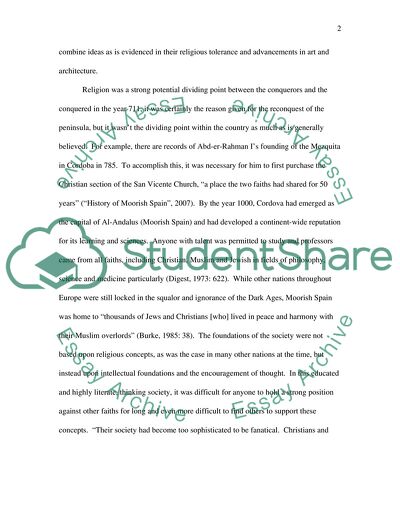
- Home
- Free Samples
- Premium Essays
- Editing Services
- Extra Tools
- Essay Writing Help
- About Us
- Studentshare
- Subjects
- Miscellaneous
- Moorish Spain: religion, art, and architecture. How the arrival of the Moors in European Spain, resulted in a hybridization culture between the two peoples, an
Moorish Spain: religion, art, and architecture. How the arrival of the Moors in European Spain, resulted in a hybridization culture between the two peoples, an - Essay Example

- Subject: Miscellaneous
- Type: Essay
- Level: Masters
- Pages: 4 (1000 words)
- Downloads: 0
- Author: edgarsanford
Extract of sample "Moorish Spain: religion, art, and architecture. How the arrival of the Moors in European Spain, resulted in a hybridization culture between the two peoples, an"
The culture that developed in this land full of Arabs and Berbers, Muslims and Christians, was among the most diverse and tolerant cultures to have existed on the planet. Buildings were sometimes divided into mosques and churches illustrating not only the architectural concepts being tested but also the tolerance of opposing religions. Architecture of all kinds flourished from the influence of ideas from both cultures and art and literature was significantly influenced by the sciences and documents that had been preserved.
This culture of Moorish influence and Spanish precedence led to a highly advanced society that learned how to live with each others’ difference and combine ideas as is evidenced in their religious tolerance and advancements in art and architecture. Religion was a strong potential dividing point between the conquerors and the conquered in the year 711, it was certainly the reason given for the reconquest of the peninsula, but it wasn’t the dividing point within the country as much as is generally believed.
For example, there are records of Abd-er-Rahman I’s founding of the Mezquita in Cordoba in 785. To accomplish this, it was necessary for him to first purchase the Christian section of the San Vicente Church, “a place the two faiths had shared for 50 years” (“History of Moorish Spain”, 2007). By the year 1000, Cordova had emerged as the capital of Al-Andalus (Moorish Spain) and had developed a continent-wide reputation for its learning and sciences. Anyone with talent was permitted to study and professors came from all faiths, including Christian, Muslim and Jewish in fields of philosophy, science and medicine particularly (Digest, 1973: 622).
While other nations throughout Europe were still locked in the squalor and ignorance of the Dark Ages, Moorish Spain was home to “thousands of Jews and Christians [who] lived in peace and harmony with their Muslim
...Download file to see next pages Read MoreCHECK THESE SAMPLES OF Moorish Spain: religion, art, and architecture. How the arrival of the Moors in European Spain, resulted in a hybridization culture between the two peoples, an
Comparison between Spain and the UAE
Islamic art and architecture from the seventh to the thirteenth century
Architect of One Culture
The Moorish Empire
The Conquest of Spain by the Moorish Empire
Will Catalan Split from Spain
Business Culture of Spain
A Political History of Islamic Spain: A Failure of Unity

- TERMS & CONDITIONS
- PRIVACY POLICY
- COOKIES POLICY